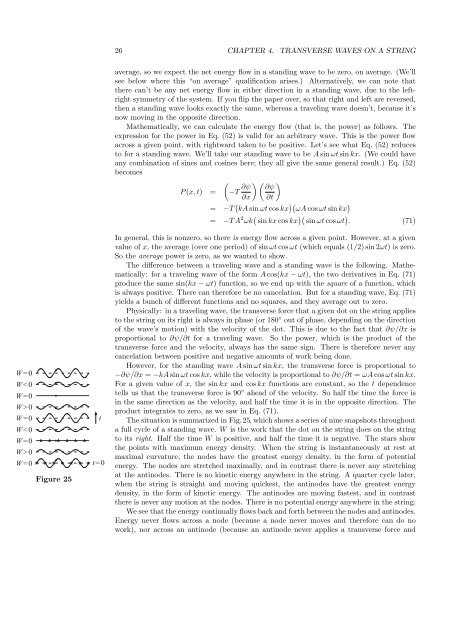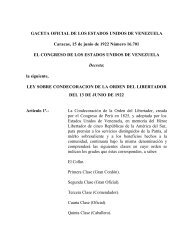Transverse waves on a string - People.fas.harvard.edu
Transverse waves on a string - People.fas.harvard.edu
Transverse waves on a string - People.fas.harvard.edu
You also want an ePaper? Increase the reach of your titles
YUMPU automatically turns print PDFs into web optimized ePapers that Google loves.
W = 0<br />
W < 0<br />
W = 0<br />
W > 0<br />
W = 0<br />
W < 0<br />
W = 0<br />
W > 0<br />
W = 0 t = 0<br />
Figure 25<br />
t<br />
26 CHAPTER 4. TRANSVERSE WAVES ON A STRING<br />
average, so we expect the net energy flow in a standing wave to be zero, <strong>on</strong> average. (We’ll<br />
see below where this “<strong>on</strong> average” qualificati<strong>on</strong> arises.) Alternatively, we can note that<br />
there can’t be any net energy flow in either directi<strong>on</strong> in a standing wave, due to the leftright<br />
symmetry of the system. If you flip the paper over, so that right and left are reversed,<br />
then a standing wave looks exactly the same, whereas a traveling wave doesn’t, because it’s<br />
now moving in the opposite directi<strong>on</strong>.<br />
Mathematically, we can calculate the energy flow (that is, the power) as follows. The<br />
expressi<strong>on</strong> for the power in Eq. (52) is valid for an arbitrary wave. This is the power flow<br />
across a given point, with rightward taken to be positive. Let’s see what Eq. (52) r<strong>edu</strong>ces<br />
to for a standing wave. We’ll take our standing wave to be A sin ωt sin kx. (We could have<br />
any combinati<strong>on</strong> of sines and cosines here; they all give the same general result.) Eq. (52)<br />
becomes<br />
<br />
P (x, t) = −T ∂ψ<br />
<br />
∂ψ<br />
∂x ∂t<br />
= −T kA sin ωt cos kx ωA cos ωt sin kx <br />
= −T A 2 ωk sin kx cos kx sin ωt cos ωt . (71)<br />
In general, this is n<strong>on</strong>zero, so there is energy flow across a given point. However, at a given<br />
value of x, the average (over <strong>on</strong>e period) of sin ωt cos ωt (which equals (1/2) sin 2ωt) is zero.<br />
So the average power is zero, as we wanted to show.<br />
The difference between a traveling wave and a standing wave is the following. Mathematically:<br />
for a traveling wave of the form A cos(kx − ωt), the two derivatives in Eq. (71)<br />
produce the same sin(kx − ωt) functi<strong>on</strong>, so we end up with the square of a functi<strong>on</strong>, which<br />
is always positive. There can therefore be no cancelati<strong>on</strong>. But for a standing wave, Eq. (71)<br />
yields a bunch of different functi<strong>on</strong>s and no squares, and they average out to zero.<br />
Physically: in a traveling wave, the transverse force that a given dot <strong>on</strong> the <strong>string</strong> applies<br />
to the <strong>string</strong> <strong>on</strong> its right is always in phase (or 180 ◦ out of phase, depending <strong>on</strong> the directi<strong>on</strong><br />
of the wave’s moti<strong>on</strong>) with the velocity of the dot. This is due to the fact that ∂ψ/∂x is<br />
proporti<strong>on</strong>al to ∂ψ/∂t for a traveling wave. So the power, which is the product of the<br />
transverse force and the velocity, always has the same sign. There is therefore never any<br />
cancelati<strong>on</strong> between positive and negative amounts of work being d<strong>on</strong>e.<br />
However, for the standing wave A sin ωt sin kx, the transverse force is proporti<strong>on</strong>al to<br />
−∂ψ/∂x = −kA sin ωt cos kx, while the velocity is proporti<strong>on</strong>al to ∂ψ/∂t = ωA cos ωt sin kx.<br />
For a given value of x, the sin kx and cos kx functi<strong>on</strong>s are c<strong>on</strong>stant, so the t dependence<br />
tells us that the transverse force is 90 ◦ ahead of the velocity. So half the time the force is<br />
in the same directi<strong>on</strong> as the velocity, and half the time it is in the opposite directi<strong>on</strong>. The<br />
product integrates to zero, as we saw in Eq. (71).<br />
The situati<strong>on</strong> is summarized in Fig.25, which shows a series of nine snapshots throughout<br />
a full cycle of a standing wave. W is the work that the dot <strong>on</strong> the <strong>string</strong> does <strong>on</strong> the <strong>string</strong><br />
to its right. Half the time W is positive, and half the time it is negative. The stars show<br />
the points with maximum energy density. When the <strong>string</strong> is instantaneously at rest at<br />
maximal curvature, the nodes have the greatest energy density, in the form of potential<br />
energy. The nodes are stretched maximally, and in c<strong>on</strong>trast there is never any stretching<br />
at the antinodes. There is no kinetic energy anywhere in the <strong>string</strong>. A quarter cycle later,<br />
when the <strong>string</strong> is straight and moving quickest, the antinodes have the greatest energy<br />
density, in the form of kinetic energy. The antinodes are moving <strong>fas</strong>test, and in c<strong>on</strong>trast<br />
there is never any moti<strong>on</strong> at the nodes. There is no potential energy anywhere in the <strong>string</strong>.<br />
We see that the energy c<strong>on</strong>tinually flows back and forth between the nodes and antinodes.<br />
Energy never flows across a node (because a node never moves and therefore can do no<br />
work), nor across an antinode (because an antinode never applies a transverse force and

















